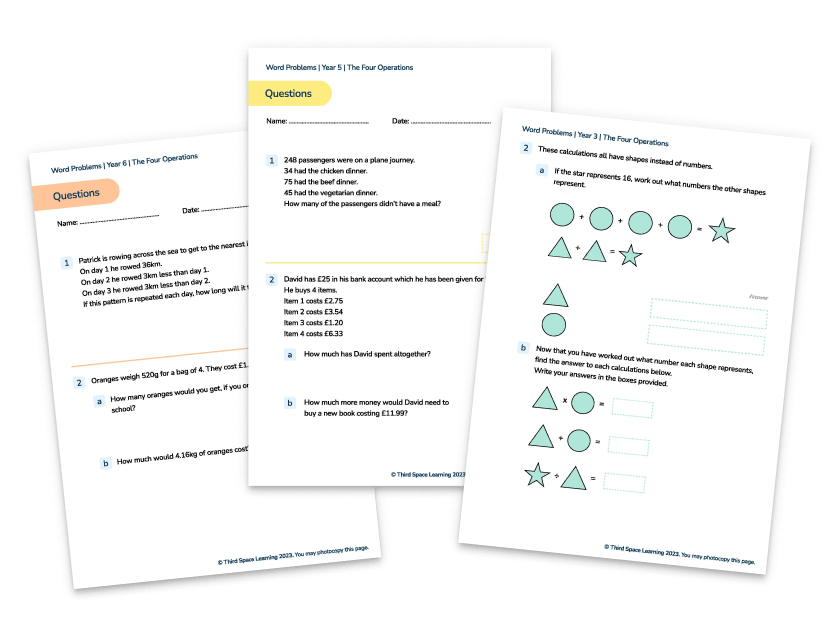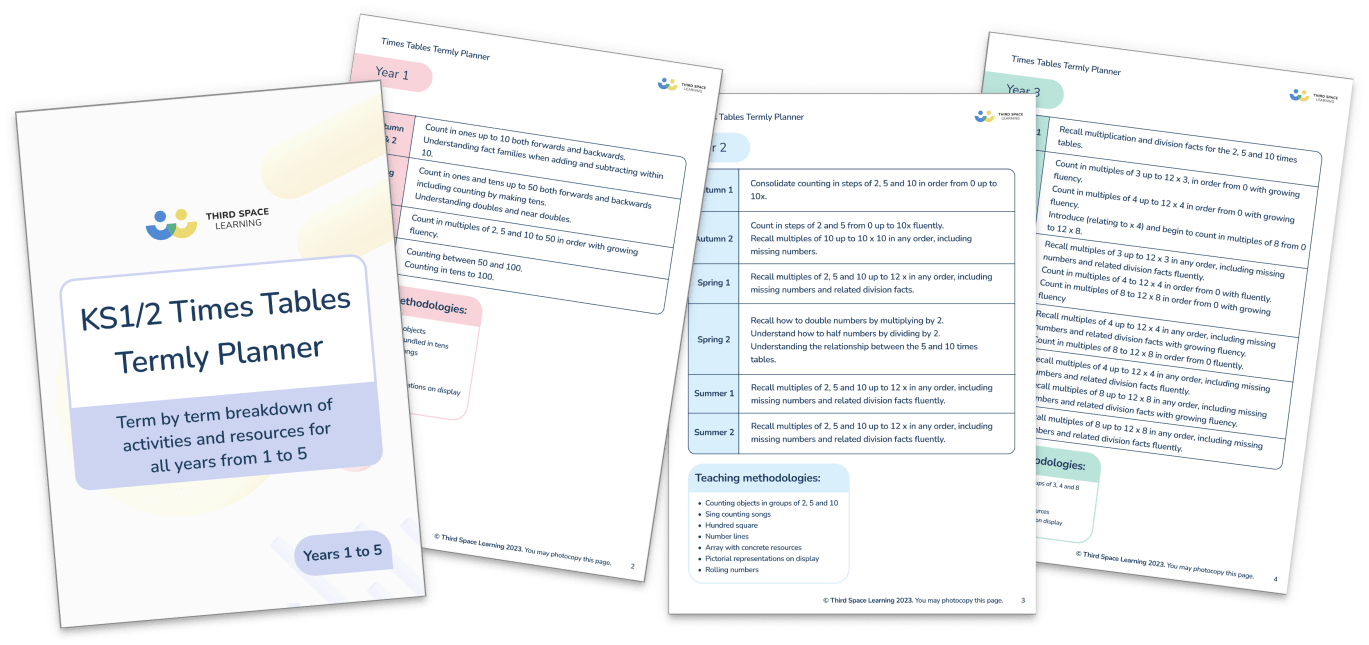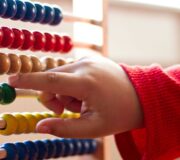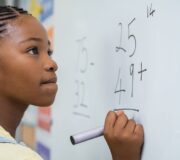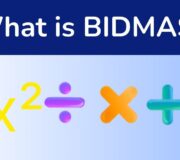How And When To Teach The Commutative Property In School (And Where The National Curriculum Has Got It Wrong!)
In this blog, we delve into the importance of the commutative property and how and why you should be teaching it to your primary school pupils. With all respect to the national curriculum, we also look at where its ambitions may be a little misplaced.
- What is the commutative property?
- What do we mean by commutativity
- Comparing the commutative law, the distributive law, and the associative law
- Commutative property of addition
- How can the commutative property of addition be used in maths?
- What the national curriculum says about commutativity
- Commutative property of multiplication – too much, too soon
- Why teach commutativity in multiplication?
- The importance of multiplicative relationships
- Commutative property practice questions
- Fluency in addition of numbers first before moving on to multiplication
What is the commutative property?
In mathematics, the commutative property (also known as commutativity) states that numbers within a multiplication or addition sentence can be moved around without changing the answer of the problem. The commutative property does not apply to division or subtraction problems.
For example:
3 x 5 = 15 and 5 x 3 = 15
4 x 2 = 8 and 2 x 4 = 8
KS1 & 2 Ties Tables Termly Planner
Download this free times table termly planner to help you to plan your maths lessons and ensure that your students know their times tables.
Download Free Now!What do we mean by commutativity
Commutativity is interchangeability or exchangeability. A mathematical expression is commutative when the order of operations within the expression can be moved around without changing the result.

Unlimited primary maths tutoring with Skye, the voice-based AI maths tutor.
Built on the same principles, pedagogy and curriculum as our traditional tutoring, but with more flexibility, reach and lower cost.
Join the schools already helping hundreds of primary pupils nationwide with Skye’s one to one maths tutoring.
Watch Skye in actionComparing the commutative law, the distributive law, and the associative law
Although there are several properties of integers to consider, during training the three number properties that primary teachers are likely to have been introduced to are:
- the commutative law;
- the distributive law;
- the associative law.
The commutative law
The commutative law is definitely the easiest of the three to understand: what children sometimes call a ‘switcheroo’. Numbers within an expression are able to be mixed around without changing the answer of the problem. The following two expressions are equal:
a + b = c and b + a = c
The distributive law
The distributive law and the associative law are not as immediately understood. The distributive law refers to how we solve expressions in the form of a(b+c).
In brief the distributive law or distributive property holds that we multiply the number (or variable) outside of the brackets by each number (or variable) within the brackets before completing the operation within the brackets: a(b + c) = ab + ac
For example, the distributive property of multiplication applied to 4(2 + 5) would look like this:
(4 x 2) + (4 x 5) = 28
8 + 20 = 28
The associative law
The associative law or associative property holds that no matter how numbers are grouped within an expression, the answer will always be the same. The associative law applies only to addition and multiplication operations.
For example, the associative property of addition means that the following expressions are equal: a + (b + c) = (a + b) + c.
The associative property of multiplication means that the following expressions are equal: a(bc) = (ab)c.
The longer I work with children, the more I find that it’s the commutative property that can cause the greatest number of problems by the way it’s taught.
Commutative property of addition
Early in pupils’ mathematical learning, as they progress through Gelman and Gallistel’s principles of counting, children learn the commutative property of addition.
As the commutative property of addition states that numbers within an addition sentence can be moved around without changing the result.
Children learn that it doesn’t matter in which order they combine groups or quantities, the total remains the same. Whether we start with a bowl with three grapes or a bowl with five grapes, the commutative property of addition means that we will always have eight grapes in total. The order of addition does not change the result (unlike subtraction and division which are non-commutative).

Commutative property formula for addition
The commutative property formula for addition with real numbers can be represented as:
A + B = B + A
We need to know two things – firstly, it doesn’t matter if we start with A or B, the answer will be the same, which is what this formula shows. However, there’s something else that isn’t visible from the formula: we can only combine like with like.
For example, apples + apples = apples. Of course we can combine apples + oranges, but then we need to understand what we are adding is fruit + fruit = fruit.
Both addends (A and B) always refer to a quantity which can be added to, or combined with, another quantity to find out how many items there are altogether.

How can the commutative property of addition be used in maths?
As they develop number sense, pupils who understand the commutative property of addition become flexible in the order they choose to combine quantities: they can look for ways to use known facts. For example, they might choose to start with the greater digit and then count on, or through prior experience they might ‘just know’ that 5 + 6 = 11, but have to think harder about the inverse i.e. 6 + 5 =11.
What the national curriculum says about commutativity
Commutative property of addition in the national curriculum
By Year 2, pupils are expected to ‘show that addition of two numbers can be done in any order (commutative) and subtraction of one number from another cannot.’ (National Curriculum 2013) Interestingly, the DfE Primary Maths Guidance (2020) suggests waiting until Year 3 to tackle this concept:
‘Manipulate the additive relationship: Understand the inverse relationship between addition and subtraction, and how both relate to the part–part–whole structure. Understand and use the commutative property of addition, and understand the related property for subtraction. (3AS-3)
We already have a mis-match between the statutory expectations of the national curriculum and the more coherent, more recently published non-statutory guidance. Pupils who have experience of working with concrete objects alongside pictorial representations such as part-whole diagrams or bar models to explore the additive relationship between parts and wholes do not usually find the commutative property of addition difficult.
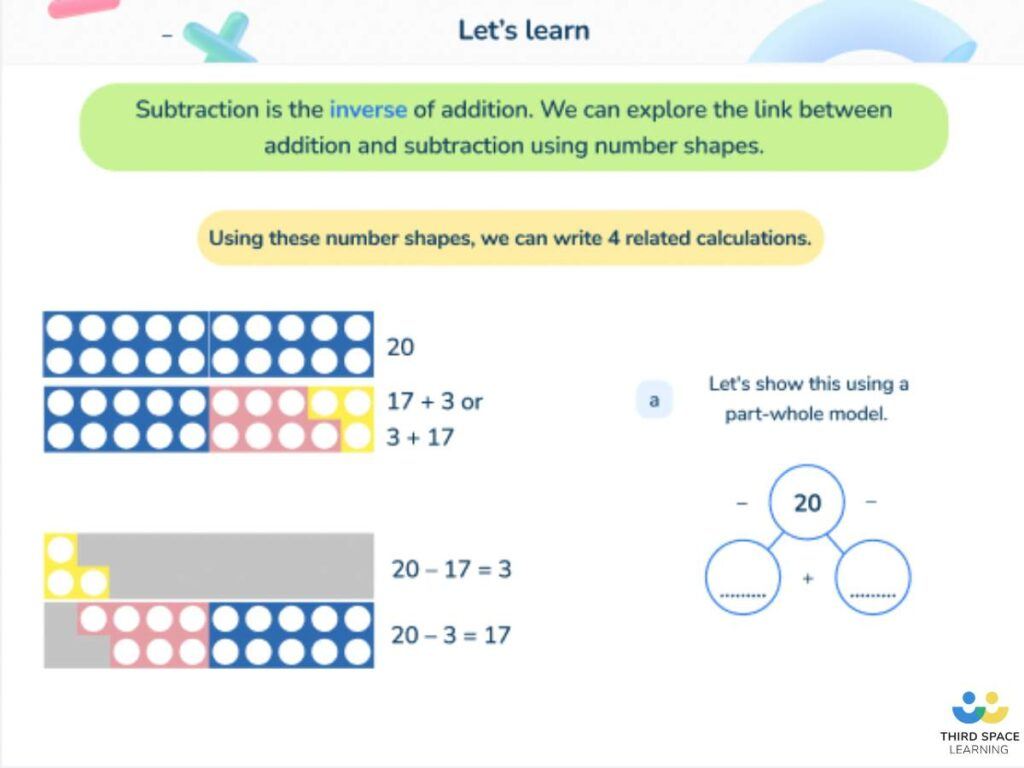
Commutative property of multiplication in the national curriculum
But then comes multiplication and things become a whole lot more complicated.
Right at the start of their journey of learning about the multiplicative relationship, Year 2 pupils are expected to ‘show that multiplication of two numbers can be done in any order (commutative) and division of one number by another cannot.’ (National Curriculum 2013). This is where the problems start.
Grouping of numbers forms the foundations of multiplication.
When pupils are first introduced to multiplication, they need a significant amount of time exploring the composition and decomposition of products into equal groups of whole numbers to ensure they fully understand the nature of multiplication as the combination of several equal sized groups. How many ways can I make equal groups from 6 counters? What if I have 8 counters? Or 9 counters?
Example of grouping numbers for multiplication
In the calculation 2 x 3 = 6, the 2 can represent either the number of counters in each group OR the number of groups I have, as can the 3.
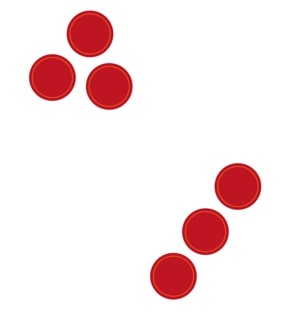
These groups of counters can be described in words as either two groups of three counters (2 x 3) OR three counters, two times (3×2).
Far too many adults are not confident to explain this image as both two groups of three counters AND three counters, two times, which means their pupils are not exposed to both ways of articulating the equal groups they see. The root of many pupils’ problems with the multiplicative relationship lies here. This is then compounded by the introduction of a new concept.
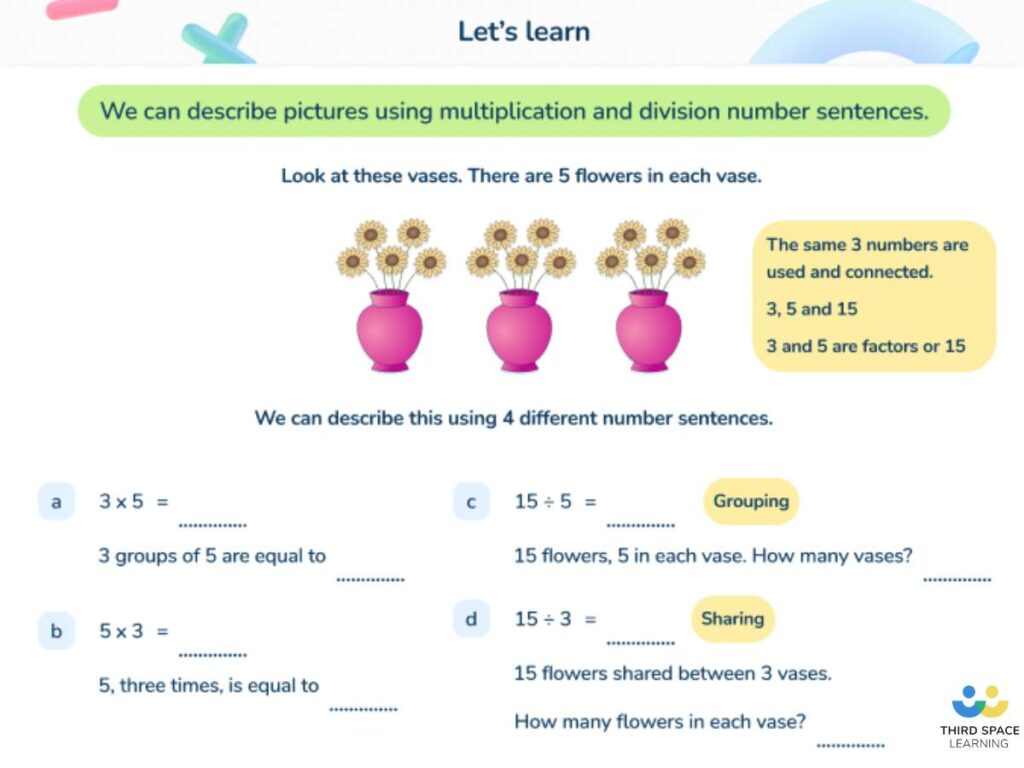
Commutative property of multiplication – too much, too soon
Before pupils have been given sufficient time and practice to really secure their understanding of what each of the factors in a multiplication calculation represents, the national curriculum demands they are introduced to commutativity in Year 2.
In other words, they are shown an image like this and expected to extend their knowledge of commutativity from addition to multiplication.
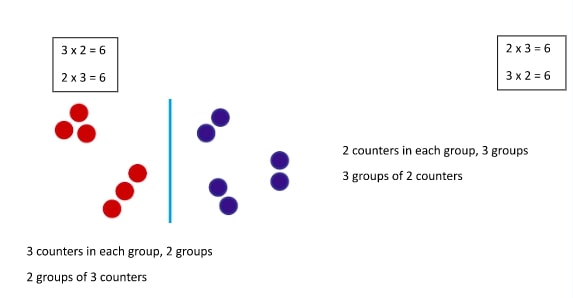
Pupils are expected to quickly learn that A x B = B x A so 2 x 3 = 3 x 2. They learn the trick of reversing the digits whilst completely losing sight of what the digits represent.
Is it any wonder children get confused? They have learnt a trick that pleases their teacher and gets the ‘right’ answer but cannot explain the difference between 2 x 3 and 3 x 2, let alone how they might be identical.
They just switch the digits round (the switcheroo referred to above) without fully understanding what they are doing. They forget that the two factors represent two different things.
How to avoid this commutativity pitfall
Before introducing commutativity, it is essential that pupils are able to accurately relate written multiplication calculations to images of equal groups of counters and articulate in full sentences the reason why the image and calculation match.
Using arrays to show commutativity doesn’t always help.
Arrays are often our go-to representation for multiplication from Year 2 onwards because they show commutativity so beautifully. As adults, they make complete sense but are they as meaningful for pupils? We represent 2 x 5 as:

and then show them how we can rotate the rectangular array so it represents 5 x 2:

However, if you show a child an array, they often struggle to know if they are reading the rows or columns as groups – are they reading horizontally or vertically?
How to avoid this commutativity pitfall
A simple fix is to alternate the colour of the rows and columns:

It’s now easier to see that the first image shows five groups of two counters and the second shows two groups of five counters.
Why teach commutativity in multiplication?
If the commutative property of multiplication is so problematic, why should we teach it?
The answer of course is just as the commutative property of addition is incredibly useful when employed alongside developing number sense, so is the commutative property of multiplication. Because we process multiplicative facts in the same part of our brains as sound patterns, the sound and rhythm of a times tables fact is important in helping us to fluently recall it.
Read more: Multiplication worksheets
The importance of multiplicative relationships
It’s not unusual for someone to know one fact instantly but have to think harder to recall the inverse. For example, I know that 6 x 8 = 48 but have to think far harder about 8 x 6 = 48. When pupils understand commutativity it significantly reduces the number of facts they need to learn. It also enables them to make the all-important connections between facts that strengthen recall.
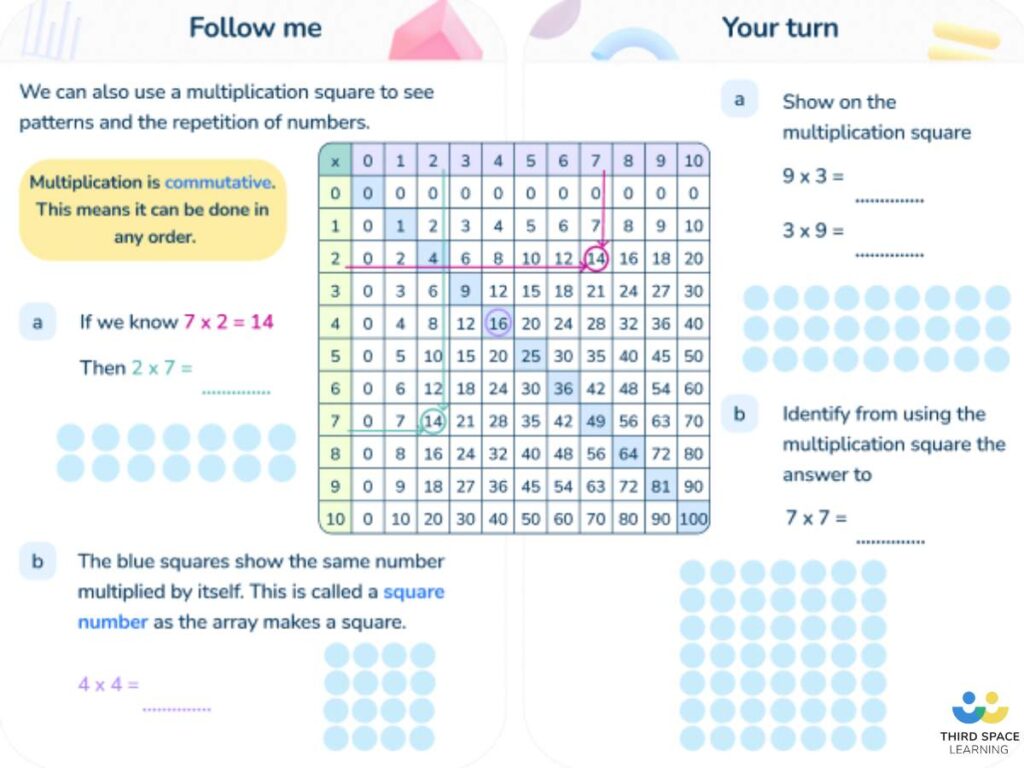
How to avoid this commutativity pitfall
Rather than thinking about times tables as a list of facts that need to be learned, teach pupils to recall linked sets of facts as a relationship, making use of the commutative property. Use pictorial representations to support this.
For example, can a pupil write two multiplication and two division calculation to match this representation?

Commutative property practice questions
If we approach the practice of the application of the commutative property of multiplication as a function of the multiplicative relationship we can move beyond procedural ‘fill in the missing number’ questions such as
9 x 5 = 5 x __
Instead, we can ask questions such as:
Using pictures of bowls of fruit, draw two pictures which can be represented by the calculation
3 x 5 = 15
This then makes it possible to apply knowledge of commutativity to word problems, for example
Write two stories that could be represented by 4 x 6 = 24
When to teach the commutative property of multiplication?
As we have seen, commutativity is simultaneously incredibly useful but also problematic. Pupils who understand and know when to apply commutative operations will find maths far easier than those who don’t.
So how do we overcome the common pitfalls with the commutative property?
The answer is to teach it later.
Move teaching the commutative property of multiplication to Year 4
Just as the DfE Primary Maths Guidance suggests teaching commutativity in addition later than the national curriculum, so it does with multiplication. Instead of teaching multiplicative commutativity to Year 2 when the initial foundations of multiplication are still shaky, the DfE Guidance recommends leaving it until Year 4:
4MD–2 Manipulate multiplication and division calculations, and understand and apply the commutative property of multiplication.
This enables pupils to have a secure understanding of what each of the factors in a multiplication calculation represent before introducing the commutative property of multiplication.
Fluency in addition of numbers first before moving on to multiplication
It is crucial pupils understand the commutative property of both addition and multiplication. However, allowing more time to ensure the foundations of understanding are secure means future learning will be far more robust.
Pupils who are secure in the additive composition and decomposition of numbers and can explain why changing the order of the numbers in an addition calculation does not change the total are now ready to explore the associative property of addition.
This will enable them to play with the grouping of the numbers in a calculation so they can use known number bonds to derive the total more easily.
Likewise, pupils who have a deeply embedded understanding that the two factors in a multiplication calculation represent two very different things before exploring commutativity will avoid the pitfall of performing tricks without understanding why they work.
These pupils will then have a secure foundation on which to build when progressing to learning about the distributive and associative properties of multiplication.
So when you’re next thinking about teaching the commutative property, consider whether now is the best time for it, or whether, in this case the national curriculum may have got it wrong!
Read more:
- KS2 SATs questions: Addition, Subtraction, Fractions, Decimals, Percentages, Place Value
- Grid method multiplication
- Long multiplication
- Long multiplication method
An example of commutative property can be seen in this calculation: 8+2 = 10 and 2+8 =10
You can solve a commutative property problem by rearranging the values if needed and then carrying out the operation.
The four basic properties of numbers are: commutative, associative, distributive, and identity property.
DO YOU HAVE STUDENTS WHO NEED MORE SUPPORT IN MATHS?
Skye – our AI maths tutor built by teachers – gives students personalised one-to-one lessons that address learning gaps and build confidence.
Since 2013 we’ve taught over 2 million hours of maths lessons to more than 170,000 students to help them become fluent, able mathematicians.
Explore our AI maths tutoring or find out about online maths tuition for your school.
